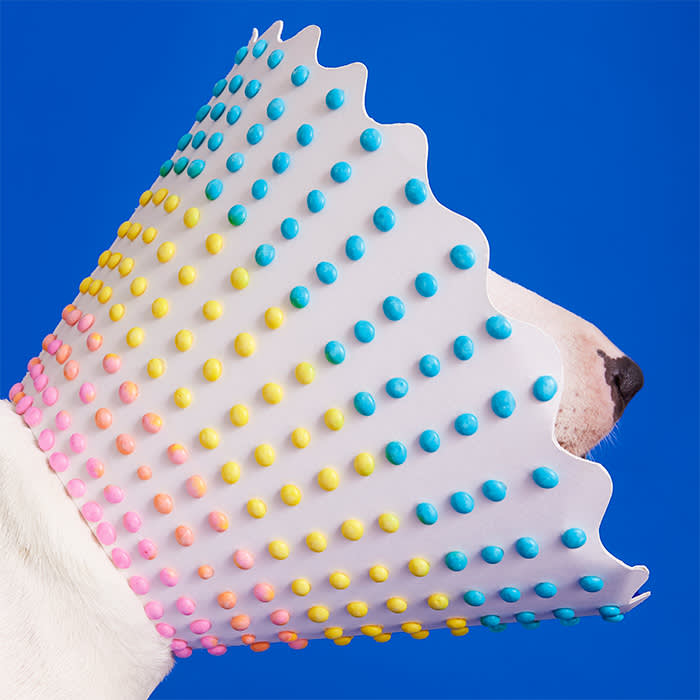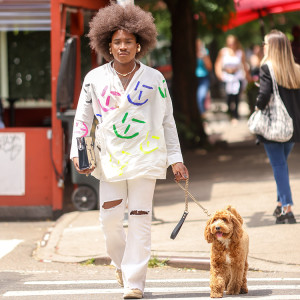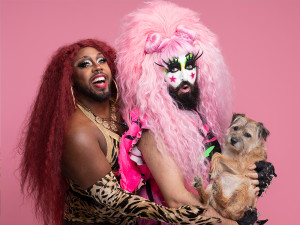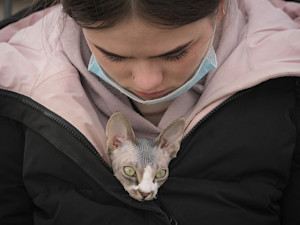These Gorgeous Dog Portraits Aim to Take the Shame Out of Cone of Shame
Winnie Au's new photography book puts a positive spin on something that usually bums out dogs—and their parents.
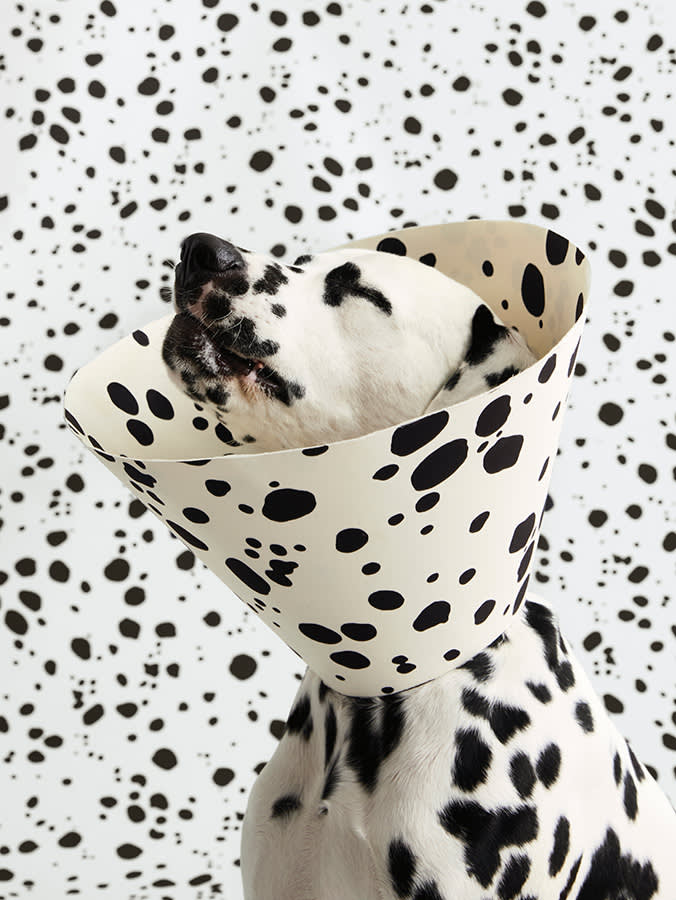
Share Article
Winnie Auopens in a new tab will never forget the moment she realized she was meant to immortalize dogs in her work. The successful New York City-based photographeropens in a new tab had shot for everyone from Vanity Fair and Elle to Google and J.Crew. But one day, she snapped a picture of her neighbor’s dog in her apartment building — impeccably lit by a nearby window, the vestibule’s artfully disheveled wallpaper adding to her photo’s timelessness.
“It was kind of a painterly portrait of a very sweet dog,” she says. “I was trying to take a picture of a dog that was more than a snapshot. What I have eventually done is try to treat dogs as equal to humans in terms of how I capture them.”

Get (totally free) deals for food, treats, accessories, tech, and way more pet parenting must-haves.
opens in a new tabA dog lover herself, Au grew up in Illinois, near farm country, with “a stray dog who just appeared at our house in the woods one day.” Over time, she began to observe how pups went from being mere pets to members of families. Ever since, she says, “Most of the work I’ve been interested in creating is about exploring that relationship between humans and animals, and how they captivate us.”
In 2012, Au and her then-boyfriend (now husband) rescued a Corgi named Tartine, who passed away in early 2014. Her latest book, Cone of Shameopens in a new tab, which came out September 10, is a magnificently chic, witty, yet soulful collection of photos that documents pups wearing Elizabethan collars, aka cones. It is dedicated to Tartine, who was diagnosed with throat cancer just a year and a half after her adoption. Among the 60 dogs who appear in the book, you will see Tartine’s “sister” Clementine (a Basset Houndopens in a new tab Au also rescued) modeling a pet cone, too.
“That was the first difficult thing that my husband and I had gone through,” she recalls of Tartine’s illness. “We did chemotherapy, all this stuff at the dog hospital. So the origin of the series, aside from it being an artistic exercise, was to find a way to turn some of the emotional, personal pain I had from losing my dog into something that could help other people. So, a portion of the book salesopens in a new tab will go to Animal Haven’s Recovery Road Fundopens in a new tab.”
We caught up with Au to detail the agony and the ecstasy of capturing pups for Cone of Shame. And while we were on that topic, we also asked her for some tips to help us budding pet-parent photographers better show off our own dogs on social media.
I wanted to talk about some of the creative expressions you have in the book — those aren’t actual cones in the photos, right?
They were all created for the book by Marie-Yan Morvanopens in a new tab. She’s more like a set designer, prop designer. I met her on a Refinery 29 shoot, and she’s very good with the abstract. She had some experience as a costume designer back in the day.
So, I kind of put all those things together, and she was totally up for the challenge. We had to create all the cones from scratch, and it was a lot of troubleshooting. Eventually, Marie-Yan just started making everything from scratch.
What were the inspirations, thematically?
We had a massive mood board, where we threw all of the ideas we had for cones and for dogs. I’d get an inspiration for a cone sometimes, and we couldn’t always make the cone [work]. One of the cones I really wanted was, like, a cappuccino foam or meringue texture. And we tried to make it with this spray foam material, and it weighed too much. But we really tried to not use things that were edible, which would distract the dogs. So, they’re just different challenges.
How did you find these dogs?
We did 60 dogs in total for the book, in photo shoots over a year. It was a mix of, like, asking all of my network and friends and family. Then I did some street casting. Like, I would hand out little flyers to [pet parents of] dogs that I thought were interesting looking. We found a bunch of dogs on Instagram.
And we also did work with an animal agency, because there are looks we wanted to include in the book. For example, the Komondor dogopens in a new tab is super unique, but nobody keeps them as pets, unless they’re super wealthy. We were looking for diversity.
What was one of the most memorable dogs to work with?
We worked with Beau, a very old dog that was a Siberian Husky, who actually is a therapy dog. This dog is like a saint. I had worked with that dog early in my career when he was much younger, and he is now, like — I don’t know — 15? A senior, senior dog. So it was very touching to see him all grown up and to work with him again.
We love the Dalmatian who looks so wistful, wearing a spotted cone in front of a spotted background.
Patch was very high-energy, but also very well-trained. I feel like he and his owner were wearing similar vibes. [The owner] was not wearing spots, but was wearing black and white. They were very in sync. When some owners and dogs work well together, it’s like watching two people dance, if that makes sense. So, they were really fun to work with, because Patch was just in love with his owner.
Oh, and we had a couple of dogs named Bowie, but this one Bowie had his own emotional support animal, his best friend named Uma. They’re both Husky mixes who are inseparable. We photographed Bowie because he was the one that would enjoy wearing the cone more. Uma was basically 10 feet away, staring the whole time.
There was also a dog named Logo who came in a backpack on a scooter. Obviously, the human owner was riding the scooter, but he looked very New York. Logo is a Lagotto Romagnolo. We did the shoot in Bushwick, and at the end seeing the dog in the backpack on the scooter riding into the sunset, I was like, “This is very ridiculous.”
Tell me about Jolie — you can’t even see her face over the cone. Was that an issue?
Jolie is a Poodle. What was great about her was that she’s very statuesque. I think part of the series was to capture the joy and dignity, trying to take the “shame” out of the cone of shame. From the artistic side of it, I was trying to take pictures of dogs that were not just cute photos. And that’s difficult to do, because all of the dogs are very cute.
So, a lot of it came down to how we would direct the dogs, and what we ended up choosing. With Jolie, she’s tipping awayopens in a new tab from that camera a little bit. What I love about that image is that there’s an abstract quality to it, some tension. And it was much more about showing the dogs as kind of sculptures, as works of art, rather than just seeing them as our cute, furry pets.
What was it like working with the Komondor? That feels like a rare experience.
Calvin’s definitely one of the most memorableopens in a new tab. Like I said, Komondors are difficult to find. I’d never met one in person, and it was quite, you know, fabulous to see one in front of your eyes. The owner of Calvin said that he had to take two baths to prep for our photo shoot.
Because I guess all of those ropes [of hair] get dirty really easily. Like, Calvin had to go out to pee in the middle of the photo shoot, and they had to tie up all of his ropes into pigtails. I was like, “This dog is amazing, but also so much maintenance.” It wasn’t just two ponytails, it was like 10 all over the body. Because she said if they pee on their cords, then the dog smells like pee, and it’s really hard to wash them.
Can the dog even see through all those cords of hair?
The dog does have eyes [laughs]! And he had a tongue and everything. They can see, even with the ropes in front of their eyes a lot of time. It was almost uncanny and strange when we saw his eyes, like, “Oh, there’s an animal under there!”
What were your outtakes like?
All my outtakes are of dogs jumping and running around and not staying in one spot. The same thing for Honey Nut, the Dachshundopens in a new tab, who is very cute. She basically got on set, and we gave her a little bit of wind, which looked really cute. She kept running away — you know, the way Dachshunds scurry?
I’m assuming Clementine, your Basset Hound, was a pro by comparison?
I usually don’t bring her to photo studios, because I thought that would give her anxiety because it might be too noisy. She was a puppy-mill mom when we adopted her, so she had a lot of trauma. We did one photo shoot at my house first. Basically, the cone I put her in just visually didn’t look right.
So we decided to do a second shoot with her, because I was, like, a nepo mom and my own dog had to be in this book. We were getting towards the end of the shoots. I made sure the other dog we were photographing that day was a dog that she was friends with. She ended up being so relaxed that all — we didn’t have a ton of crew — but everybody who was there was able to come out and say, “Hi” to her. So I was very proud.
It can be so challenging to capture any dog’s cute moment. What are your tips for pet parents who aren’t professional photographers?
I would say the first one is to get low on the ground at their eye level. Because if you think about the way we photograph humans, it’s usually kind of seeing eye-to-eye with them. That’s how you show a connection. So you basically have to be prepared to squat or get slightly uncomfortable.
What about treats?
If your dog is treat-motivated, it obviously helps. But one of the main tips is to train them to sit and stay, in the first place. Like, when we cast for the book, I did say, “Your dog has to know how to sit and stay.” Basically, they just needed to know those commands.
How many treats did you go through shooting this book?
A lot. Usually, I’d have the owners come to the shoot, and I would ask them to bring the dog’s favorite treats. The dogs I was most impressed by did not use any treats and were incredibly well-behaved.
We were like, “I cannot believe they’re just doing everything the owner says.” Not that it’s bad if you do use treats. My dog is very treat-oriented. When I photograph her, I go through, like, three string cheeses — tiny little bits each time she stays. You don’t want to overdo it, either. You don’t want to give your dog a stomach ache.
Any other tricks? It can be so hard to get them to look at the camera.
I do make a high-pitched noise to get dogs to look at me. I do this weird thing that sounds like a dolphin. At some point in my life, I realized it made the dogs look at me. A lot of animal handlers use a squeaky toy or something. It kind of depends on the dog. But I feel like my trick works because the dogs aren’t expecting that.
But also, I want the dogs to look directly at me and the camera lens, and not look at the hand to the side [holding a squeaky toy]. It depends on the dog, but you can use a whistle sound to get their attention, too. However, that trick only works for a little bit — it wears off.
So you make the noise, and you just have to be really quick on the draw?
Yes. The other thing is to work in a favorable condition — meaning, if you’re trying to take a picture of your dog at home, wait till they’re in a comfortable spot, curled up on the couch or in their favorite bed. Then approach slowly and quietly and take the picture. If you try to force them into something, it doesn’t always work.
What about lighting? Dogs usually don’t like a camera flash.
I would say your chances of getting something good are better outside. Like, if your dog rolls around in the grass, that’s a great time to try and take a picture, or at their favorite spot in the shade or something under a tree. A park would be a good spot to try, but you want to try to get them to sit and look at you.
If they’re treat-oriented in the home, I would suggest going near a big window, kind of facing your dog towards the window, more like a side light. Because if it’s your own dog, you’re spending a lot of time with them. It’s easier to capture the moment than it is to force them into something that they don’t want to do.
Keeping a dog’s comfort in mind, how does that relate to your book?
I never recommend anyone to do anything your dog doesn’t want to do. One of the criteria for the book was that we made sure all the dogs were comfortable wearing cones. And if the owner said, “Oh, my dog’s never worn a cone,” we shipped them a cone to practice with. If it was giving them a lot of anxiety, I would say, “Just don’t do it.”
When we put the cones on the dogs, we usually let the owners do it. I would never suggest you do something just for a photo if it makes your dog uncomfortable. Every animal is different.

Nisha Gopalan
Nisha Gopalan has been a writer/editor for The New York Times, New York magazine, Entertainment Weekly, Variety, The Hollywood Reporter, and NYLON magazines. She currently resides in Los Angeles.
Related articles
![Person with a large curly brown afro wearing a stylish two-piece white suit with multicolors designs on the coat walking their dog in the city]() opens in a new tab
opens in a new tabWatching New York Hits the Streets for Kinship
Street style photographer Johnny Cirillo goes on assignment for us to chronicle New Yorkers’ best accessories: their pets.
![Photo by Heike Schneider-Matzigkeit]() opens in a new tab
opens in a new tabI’m with the Band: Heike Schneider-Matzigkeit Photographs Rock Stars & Dogs
The Berlin-based artist has shot Amy Winehouse and Iggy Pop. Her new gig is taking portraits of creatives and their pets.
![]() opens in a new tab
opens in a new tabPhotographer Angela Pham on Training Her Japanese Spitz
How she taught Turtle to ring a bell, open a door, count to four, and walk with a limp!
![Gerrard Gethings]() opens in a new tab
opens in a new tabCats, Dogs, and Drag Queens — Through the Lens of Gerrard Gethings
The photographer talks about his Border Terrier assistant, the likeness of people and their pets, and going behind the scenes with drag queens.
![a cat rests in a girl's jacket]() opens in a new tab
opens in a new tabMeet the Photographer Documenting Pets at the Ukraine Border
Christopher Furlong is helping fleeing pets and people tell their stories.
